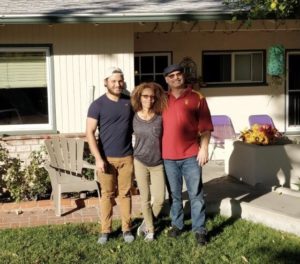
Little Stan, Cathy and Stan
Cathy and Stan live as a big, happy family in their Momentum Valley Village group home where they care for six men with developmental and intellectual disabilities. In that home, they shared major life events with the guys. “We’ve shared our wedding and we raised our son Stan.” They feel fortunate for the trust families put in them to care for their children, right down to the home-cooked meals they make each day and eat together as a family.
Cathy and Stan left their home at the beach in 1991 to begin working in the San Fernando Valley for Momentum Valley Village in a group home. Both had backgrounds in healthcare. Stan had worked in a residential program with 35 clients in Pennsylvania and then in the mental health department at USC. Cathy had been an x-ray technician. “When we first moved into the group home, there had been a lot of staff turnover. We had to create an environment based on consistency that allowed the guys in the home to improve behaviors and to thrive with us. Through the relationships we made in the home, we were able to provide care based on prevention, identifying possible issues by observing body language, recognizing patterns and other nonverbal cues to prevent escalation to more serious issues.”
Cathy and Stan humbly accept the impact they’ve made in the guys’ lives and their families. “We are doing our job. The greatest gift parents and their children can give us is their trust to make choices in their best interest.”
Cathy and Stan raised their own son – Stan – in the home with the guys. He was an only child with six big brothers. Cathy says, “He learned patience at a young age. When I was passing meds to clients, he learned to wait patiently if he wanted my attention. Through this experience, he is a calm, patient person.” Looking around the living room, I see photos of Cathy, Stan, little Stan and the guys sharing moments over the years. The home is very comfortable and does not feel institutional in any way. Cathy goes on to say, “Stan was intuitive about which of the guys to engage for which activities. Some were great at video games while others excelled at puzzles and others loved to color. He took the initiative to engage with them as members of the family.”
The family did everything together, including taking Stan to school, to baseball games and other activities. Cathy and Stan both tell me, “Stan’s first day of middle school is a memory we will not forget. Someone from licensing came for a routine check-in. We all got into the van as usual and took Stan to his first day of middle school along with the surveyor. When we dropped him at school, they guys wished him well, and Stan was on his way. Growing up together was good for Stan and the guys.”
Another memory that stands out is from Stan’s time playing baseball in high school. “Even though he was grown up, the guys called him Baby Stan.” When he played baseball, the guys came to his games. One year at an annual awards banquet, two of the guys earned most valuable coach award from the team managers. Stan saw how happy they were to be honored with the award, and he wrote a story about it for school. He learned the meaning of feeling happiness when someone else is happy, knowing what it meant for them to be honored and how they felt at that moment.
Over the years, their home became the hub of the neighborhood. Neighbors and their kids would gather at the house. Stan, his friends and the guys played games and interacted. The feeling of community in their neighborhood was genuine. The impact of the care they provided they guys reaches beyond the walls of the home they live in.
Cathy shares that “One of the guys starts every morning by saying, “Good morning! I love you!” and gives me a big hug. That’s the best way to start every day. With a feeling of happiness, love and excitement! We feel very fortunate for this experience, that the families and parents trust us to raise their children and for giving us the opportunity to bring their family to ours.”
